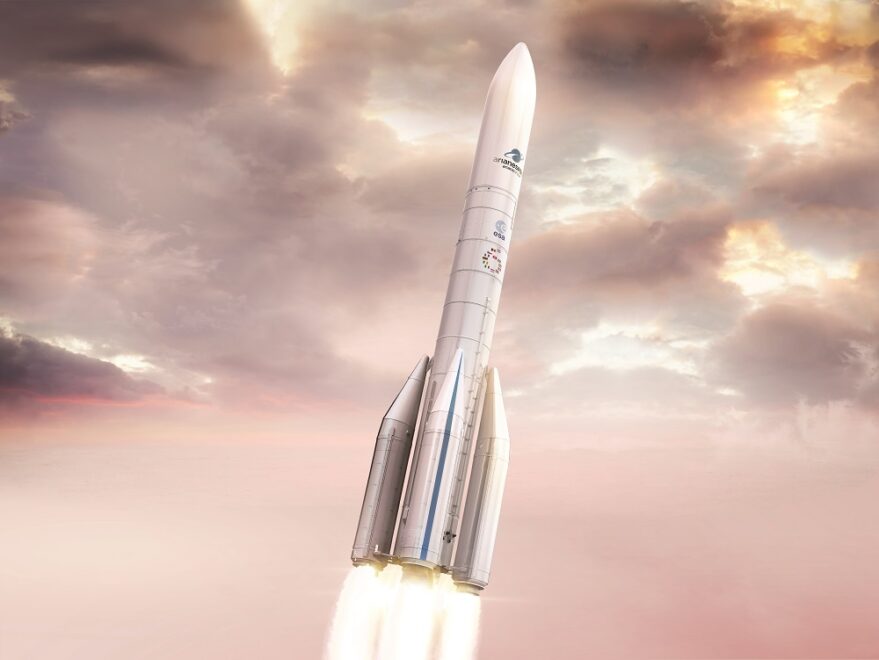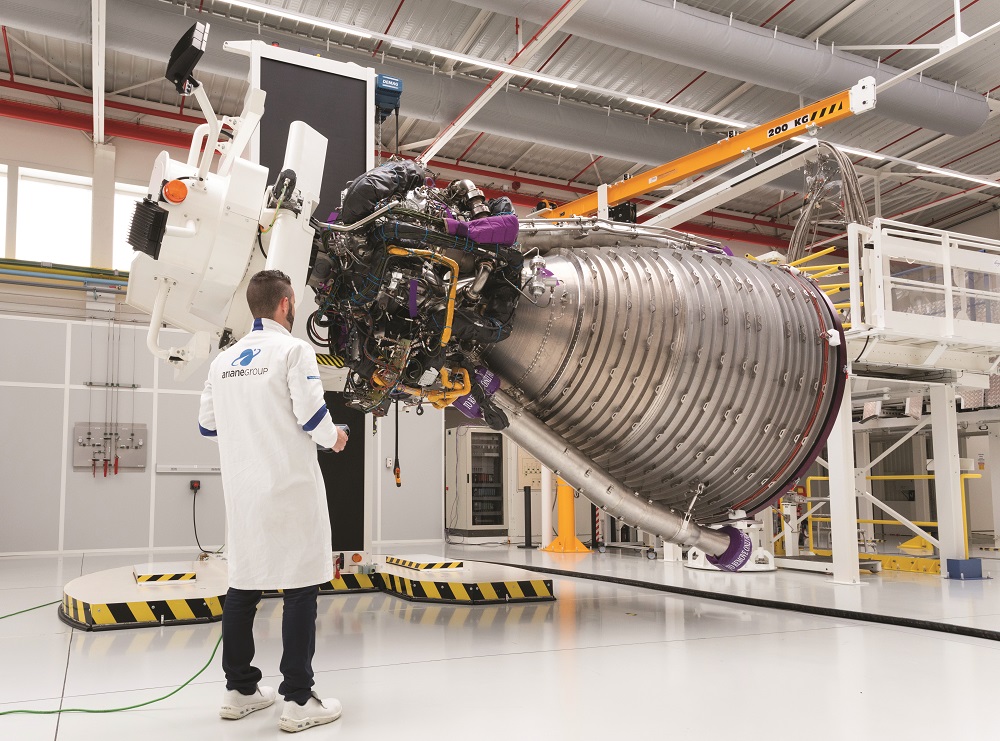ArianeGroup is preparing final tests for the upgraded heavy-lift Ariane 6 rocket it hopes to launch for the first time next year.
The inaugural launch will mark the culmination of years of joint efforts from several European space organizations to give Arianespace, ArianeGroup’s subsidiary in charge of operating and marketing the Ariane family of rockets, the tools to fight for market share against SpaceX and its reusable rockets as state-subsidized launches out of China, Russia and India gain traction.

France-based ArianeGroup is in charge of developing the successor to Ariane 5’s workhorse and its production facilities, while France’s CNES space agency is responsible for its launch complex, including its launchpad and associated facilities in French Guiana.
The European Space Agency (ESA), meanwhile, is acting as launch system architect for Ariane 6 to ensure the consistency between the launcher and its launchpad.
They are tasked with succeeding one of the world’s most reliable launch vehicles, which is currently preparing to launch the $10 billion James Webb Space Telescope Dec. 18 in one of Ariane 5’s last missions.
However, the launch industry has changed dramatically since work started on Ariane 6 in 2014, bringing new demands from constellation operators as well as competition from existing and emerging rocket companies.
SpaceNews spoke with Franck Huiban, who leads ArianeGroup’s Ariane 6 program, about how it is adapting Ariane 6 for this fast-evolving market as the pandemic throws a wrench into the works.
COVID-19 helped push the inaugural Ariane 6 launch to the second quarter of 2022, from 2020. With the pandemic still being felt across the world, how is that schedule looking today?
We’re aiming to launch as soon as we can in 2022. In the coming weeks and months we’ll have a series of important tests to check everything is working fine. First in Germany with the country’s DLR space agency to test Ariane 6’s upper stage, as a whole, including its engine and all associated systems. That’s almost as complex as a launch.
In parallel, we will have the combined tests in Kourou between the launcher and launchpad. It is difficult to devise a precise launch date before these major system-level tests, but we will do all we can for a successful launch. A launch date is important, but a successful launch is even more important.
But you still feel good about Q2 2022?
It is a challenging objective, but this is the target we gave ourselves and defined by ESA, our customer in this story. If at some point we need to take some more time to increase robustness, we will. We need this first flight to be a success.
Is this why Arianespace has not announced a customer for the inaugural launch?
The very first launch is a qualification launch, and we usually do not have a customer for this. Some of our competitors would launch cars or cheese into space…
We’ll also try to be creative. ESA is about to publish a call for launch opportunities intended, I would say, for academic projects. We would be happy to have customers on the maiden flight — but it would definitely not be driven by commercial interest.
So we don’t yet know who the passenger for the maiden flight will be.
Who is Ariane 6’s first commercial customer at the moment?
The second launch will be for Galileo, which is not commercial. Arianespace, the company responsible for marketing and operating the launch service, has announced a contract with Viasat, which is today the first commercial customer on Ariane 64 [Ariane 6’s four-booster variant].
Other than delaying the start of services, how else has this new schedule affected Ariane 6’s development?
Even without the delay, Ariane 6’s design has changed a lot since ESA member states started the program, for many reasons. The first one being the evolution of the market on the demand and supply side. The market has become much more segmented with the development of non-geostationary applications over the years.
We have done our best to catch up. When we started Ariane 6 in 2014, almost nobody predicted the evolution we’ve seen over the past seven years, and the dramatic development of constellations, for instance. Today we have a very versatile Ariane 6 that also perfectly fits the needs of constellation customers. Arianespace regularly indicates they receive strong expressions of interest and their teams are in advanced discussions with potential customers.
One of the main evolutions between Ariane 5 and Ariane 6 is the upper stage. Ariane 6 has the Vinci re-ignitable engine named Vinci; Ariane 5 does not. This opens the door to a much broader scope of missions to any orbit. And we have added an APU, an auxiliary power unit, that provides additional capability to accommodate more complex mission profiles. With the APU, Ariane 6 is able to deploy constellations and populate a full plane of satellites with only one launch. The APU was made possible through additive manufacturing that reached maturity at the time we started developing Ariane 6, and was not part of the initial plan.
So the delays have given you more time to implement new features?
It’s more complex than that, and interrelated. When the pandemic started, we had disruption in the supply chain like all industries, so we had to reorganize our development strategy. In some cases we could go deeper on specific innovations. In others we had to optimize to go faster, to compensate for the delays. Today we have a roadmap that I would say is the combination of the pandemic, the innovations we have embarked on, and also the normal life of a development process.
So where do Ariane launchers fit in a world dominated by Falcon 9, Falcon Heavy, and potentially Starship — with Rocket Lab, Relativity and others also eyeing Ariane market share?
That is a question for Arianespace, but what I can say from my side is that Ariane 6 is being developed first of all to address the launch needs of European institutional customers, including the European Commission, ESA and the member states. Each space power needs to keep a sustainable, independent and reliable access to space. The commercial market comes on top and Ariane 6 will serve it successfully.
We started Ariane 6 because, after several decades of good services, Ariane 5 was coming to an end, and it is important for European states to keep their autonomy in accessing space. So we cannot make a direct comparison between two launchers on a specific segment of the commercial market. At stake is the ability to deliver public services for applications such as security, communication, navigation, observation, etc. Along with projects such as Galileo, there’s also a project to develop a new connectivity constellation at the European level.
When we come to the commercial market, from the feedback we’re getting and contracts obtained by Arianespace, it’s very clear that there is a huge demand – especially for the deployment of constellations, but also from a large variety of historic and new segments. Customers are all looking for flexibility and launch service providers have to address a greater variety of mission requirements – mix of masses and orbits, availability and responsiveness – than in the past. Thus, there is a need to have a broad range of launch solutions for customers. Ariane 6 fully meets these expectations from the market, being adapted for the majority of the segments.

How does ArianeGroup assess the competitive threat posed by Blue Origin’s New Glenn? Several years ago, they announced contracts with several would-be Ariane 5 and Ariane 6 customers.
Competition is an indication of growth, and how the market is becoming more and more dynamic. SpaceX and Blue Origin are serious players, but we are convinced that Ariane 6 will remain a key player for the commercial market. For instance, Arianespace has already signed the equivalent of eight to nine launches, even before the maiden Ariane 6 flight.
If demand for launch services increases, then there might be room for more than two or three launch service providers worldwide.
International competition has never been as intense for the launch industry, and your competitors are also not standing still as SpaceX pushes ahead with its next-generation launch vehicle. How does ArianeGroup stay competitive for the long term? What comes after Ariane 6?
We have advanced technological demonstration projects that are less known outside ESA circles that include, for instance, Prometheus, which is a very low cost oxygen-methane reusable engine which we are developing under a contract with ESA. We plan to have the first firing test of this new engine in the coming months, end of 2021 or early 2022.
In parallel we have Themis, a demonstrator for a reusable main stage that we have already started to test that uses Prometheus as an engine.
We have a 10-year roadmap discussed with ESA, which also recently launched a study called NESTS, or New European Space Transportation Solution, which has a very long term perspective of 2030 or beyond. We’ve built a very diverse consortium of companies and academics in Europe to look beyond Prometheus and Themis — and the place we want to have in the worldwide landscape of space transportation.
We’re also preparing to master reusable technology. At the time we launched Ariane 6, it was not the obvious decision. The launch rate worldwide led us to go for an expendable launcher. It was obviously the right decision because it allows us to succeed Ariane 5 very soon with Ariane 6, and to have more time to prepare for really disruptive reusability technology.
SpaceX credits a lot of its success on its drive to reuse rocket boosters to cut costs and increase launch cadence. Is ArianeGroup planning to evolve Ariane 6 to incorporate reusability and when could that happen?
The keyword for Ariane 6 is flexibility and we designed it with a focus on modularity, meaning it will evolve. We have competitiveness improvement programs with ESA to increase performance, reduce exploitation costs and expand mission domains.
So yes, Ariane 6 will evolve. Will reusability be the first feature we add to Ariane 6? I’m not sure. As a first step, I would say we will focus on improvements which make more sense in terms of return on investment. We may, for instance, develop a new upper stage that is much lighter, based on composite technology to increase mass performance and reduce cost. We could develop new solid rocket boosters to get more performance, and so more competitiveness.
When we look at the global landscape, there are expendable launchers still in operation, including in the U.S. Reusability is key to prepare the future, but there is also room to innovate and progress with expendable launchers.
SpaceX’s need for frequent Starlink launches is an important factor for the viability of its reusable boosters. Could reusability play a greater role for ArianeGroup’s when you are launching Europe’s proposed broadband megaconstellation?
We’ll prepare for it anyway. It does not depend on one specific project. Launch rate will help, definitely, and any project that increases launch demand adds more sense for reusability. But we’re also considering that for a long-term perspective to keep as many doors open as we can.
Something else that happened while you were developing Ariane 6 is the proliferation of small launch rocket developers, more than 120 of them. As some of these mature in Europe, could ArianeGroup end up partnering with them?
It’s difficult to imagine one launcher or one launch system would fit all needs. We’ve always leveraged the concept of the European launch family, and this is the case today with Ariane 6 and Vega C. There could be a place for a smaller launcher for lower masses — why not? It’s important for ESA and Europe to maintain this synergy within a product family.
The development of early stage launchers in Europe is again good news. We have partnerships with startups for the NESTS study I mentioned. We have partnerships with startups wanting to use ArianeGroup facilities and knowledge. We will see more of an ecosystem developing — it’s an opportunity even though it may develop competition.
What other future opportunities are out there for Europe’s launch market?
Europe is maybe the only space power today not really investing in human spaceflight. There is a debate cropping up again about it. This is something we’re interested in and excited about, because we have a lot to bring in case European states want to go this way.
What is the next step for that? What kind of timeframe are we looking at, and how does something like that get added to your development schedule?
It’s difficult to devise a roadmap for such an ambitious project, but every three years ESA has an important rendezvous and the next ministerial council will be November 2022, when ESA will decide the roadmap for the next three to five years. But all this is very hypothetical at this stage.
This interview has been edited for length and clarity.
This article originally appeared in the November 2021 issue of SpaceNews magazine.
